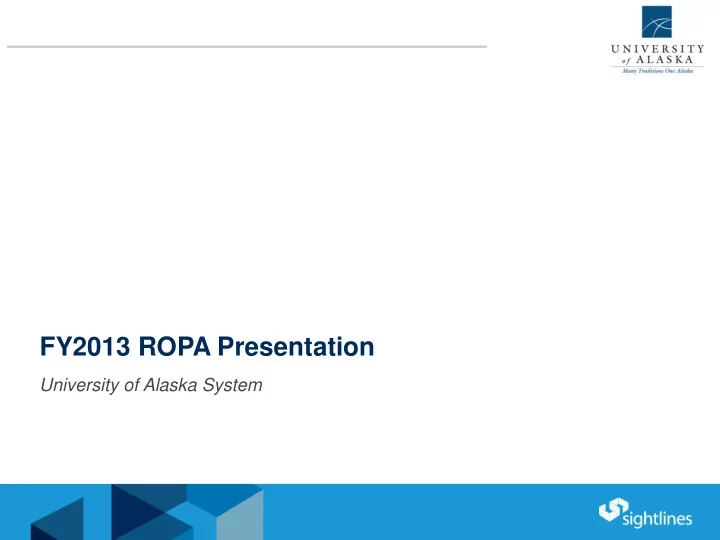

FY2013 ROPA Presentation University of Alaska System
A vocabulary for measurement The Return on Physical Assets – ROPA SM Asset Value Change Operations Success The annual The accumulated The effectiveness of The measure of investment needed backlog of repair/ the facilities service process, the to ensure buildings modernization operating budget, maintenance quality will properly needs and the staffing, supervision of space and perform and reach resource capacity to and energy systems, and the their useful life correct them management customers opinion of service delivery Recurring Capital One-Time Capital Annual Asset Operational Service Stewardship Reinvestment Effectiveness System Comparisons Connecticut Maine Mississippi Missouri New Hampshire Oregon Pennsylvania
Summary of main points University of Alaska System Campus & regional characteristics are demanding • A combination of factors make both operational and capital management of facilities at UA System more difficult: • Complex building systems – impact maintenance coverage, skill mix, and cost • High building intensity – more buildings to tend to and different types, also impacts maintenance coverage, skill mix, and costs • High cost – regional costs means dollars don’t go as far as they do for peers Higher levels of daily service compensate for campus demands • Facilities’ operating budget has grown more quickly than peers • UA System’s maintenance and custodial departments are covering more buildings than peers and has increased coverage by over 15% in the last 3 years • Customer satisfaction survey highlights improvements & opportunities Rising investments, closing the target gap • Stronger investments into existing facilities has primarily come from one-time sources of capital and has helped narrow the gap between targets • Upcoming renewal needs are expected to be greater than the historical recurring capital levels, furthering the importance of continued campus reinvestment
Majority of space in high-need category Average Life Cycle Costs – Standard Academic Building $60 $55 $50 $45 $40 $35 $/GSF $30 $25 $20 $15 $10 $5 $0 0 2 4 6 8 10 12 14 16 18 20 22 24 26 28 30 32 34 36 38 40 42 44 46 48 50 Annual Life Cycle Cash Flow Amortization of Life Cycle Expenses 10 – 25 Years Under 10 25-50 Years Over 50 19% 21% 51% 9% * Life cycle costs based on the average tech 3 academic space.
Total capital spending Heavier recent investment in new construction Total Capital Spending* $250.0 $200.0 $150.0 Millions $100.0 $98M $50.0 $0.0 FY2006 FY2007 FY2008 FY2009 FY2010 FY2011 FY2012 FY2013 Existing Space New Space/Non-Facilities
NAV index steadying with increased investment System is nearing Systemic Renovation Stage NAV Index 100% Capital Upkeep Stage: Primarily new or recently renovated buildings with minor capital needs; 90% “You pick the projects” Repair & Maintain Stage: Buildings beginning to 80% 76% 76% 75% 74% show their age, may require more significant 73% 72% 72% 72% investment on a case-by-case basis 76% 75% 70% 74% 71% 73% 70% Systemic Renovation Stage: Buildings require 69% 68% more significant repairs and large capital 60% infusions; “The projects pick you” 50% Without asset reinvestment investments, Transitional/Gut Renovation/Demo Stage: 40% Repl. Value – Backlog NAV would decrease by 8% and over Major buildings components are in jeopardy of NAV = $607M would be added to backlog within failure. Reliability issues are widespread Repl. Value 30% 7 years throughout the building 20% UA System NAV UA System NAV w/o AR 2006 2007 2008 2009 2010 2011 2012 2013
ROPA+ prediction model 10 year total renewal need: $235.7M; annual deferral UA System ROPA+ Prediction Model 10 years $120.0 Low Risk (Space Renewal) $100.0 Medium Risk (Envelope) High Risk (Mechanical) $80.0 Millions $60.0 $40.0 $23.6M avg. $20.0 $0.0 2006 2007 2008 2009 2010 2011 2012 2013 2014 2015 2016 2017 2018 2019 2020 2021 2022 2023 *B-Line does not reflect existing deferred maintenance, utility & grounds infrastructure needs or upcoming modernization need
Key Takeaway #2 The UA System already has an estimated $1.13B in deferred maintenance, infrastructure, and modernization backlog: • $425M of deferred maintenance identified through ROPA+ analysis • Estimated $708M backlog in campus infrastructure and modernization Over the past 8 years, the UA System has invested an average of $35.5M into the existing facilities. If the historic investment trend continues over the next 10 years the total expected investment would be $355M, roughly $778M less than the existing backlog of deferred maintenance and modernization need. $1,200 $1,000 $ in Millions Remaining Backlog $800 $708 with Sustained $778 Reinvestment Spending $600 $400 10-Year Average $425 $200 Reinvestment Spending $355 $- Backlog Future Reinvestment
Key Takeaway #3 If reinvestment investments increased by 15% over the next ten years, UA system would be able to invest approximately $408M into deferred maintenance, infrastructure, and modernization needs. Increase in overall investment results to a rising NAV by 6%. 10 year investment scenario Projected NAV 100% $1,200 90% $1,000 -$355 72% 72% 73% 74% 74% 75% 76% 76% 77% 78% 78% 80% +$149 $800 $ in Millions -$53 70% 60% $600 $1,133 Additional 50% Investment by $874 $400 15% 40% $200 30% 20% $- 2013 2014 2015 2016 2017 2018 2019 2020 2021 2022 2023 FY13 Backlog 10-Year Additional FY23 Reinvestment Deferral Projected Spending Backlog
Key Takeaway #5 Continue to communicate strategic plans, such as the Investment Quadrant Chart, University Building Fund, and Sustainability Funding Plan to each campus to aid in projecting upcoming needs and capital planning.
Key Takeaway #6 Identify key metrics for monitoring performance toward future goals. The upcoming detailed analysis of the customer satisfaction survey could identify some areas for improvement. Sample Performance Goal Dashboards Capital Investment +5% (% Invested in Envelope/Mechanical) Change in Energy -5% Consumption (% Change in total BTU’s/GSF) Operating Budget +/- 1% (% difference budget vs. actual) Planned Maintenance 8% (% of facilities operating budget)
Recommend
More recommend